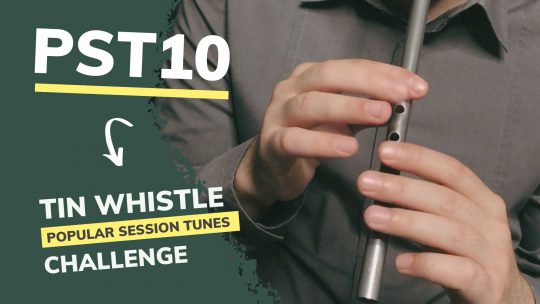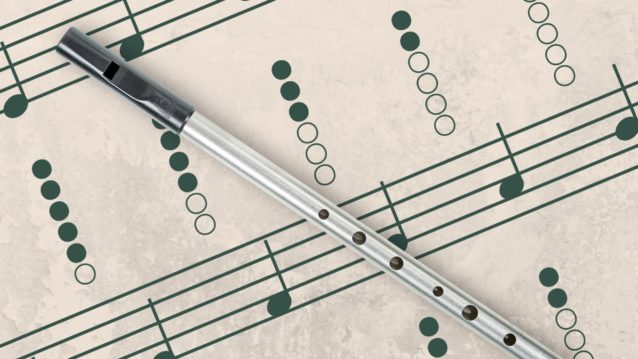In this lesson, we will learn the tap, a very simple tin whistle (penny whistle) ornament. You may come across its alternative names, as some people tend to call it “strikes” or “pats” or “strucks”. While it’s a nice decoration in Irish traditional music, it is rarely used as a standalone ornament. You will more often hear it as part of a roll, which we will cover in the next lesson.
How and when to use taps on a tin whistle?
As the name suggests, you tap the note (hole) with your finger. Two simple rules explain a tap.
- You cover the hole with the finger below the note you are playing and then lift it.
- You do it very fast. Well, literally “tap” it.
As you can see, it is the exact opposite of a cut ornament, which we learned in the previous lesson. For example, doing tap on a note G means that you play a note G, and then tap with the finger below, which is on the note F#. For a note E, you tap with the finger on D (your ring finger), and so on.
In technical terms, you use a tap after you already played one note of the same pitch. Therefore, you use it to play repeated notes, instead of tonguing, for example.
However, other tutorials may advise a tap can be played not only on repeated notes but just before you play the main note. Which is making a decoration that sounds like pronouncing “tou-a”. But, to our beliefs, that’s pretty much the same technique as a slide ornament. It’s just a very short slide. You can, however, call it a tap, but this doesn’t change the fact that it sounds the same as a slide.
A tap is rarely done as a standalone ornament. You will more often hear it as a part of a roll.
LearnTinWhistle.com
Practising taps on a tin whistle
Since taps are mostly used on repeated notes, you should practice ascending and descending scales, making sure to play the same note two or three times before moving on to the next one. Obviously, you cannot play a tap on a note D (as there is no hole below). So, start with a plain E note, then tap it two times, then move to F#, and so on. And as we previously mentioned, make sure you do tap as fast as you can. Covering the hole should be very short, as we don’t want to hear the other note, we are just decorating the main one.
As always, use a metronome and play at its pace. Keep in mind that taps should fall exactly on the beat, the same as you would repeat the notes by tonguing. As with cuts, a tap is not a grace note either. It’s an articulation of the principal note.
An example of tin whistle taps in tunes
Below, you can see how to use taps to play repeated notes instead of just tonguing. The first example is a popular beginner song, the Star Of The County Down, followed by the example of the Lilting Banshee (jig).
And here’s the sheet music and tabs for the previous video examples. The notes where we play taps are marked with the letter “T”.

You may notice that at the beginning of the Star of The County Down, there are 3 repeated E notes, and we play the tap only on the last one. That’s because taps usually sound awkward when played twice in a row.
The same “little rule” applies to the Lilting Banshee example below (notice three repeated E notes in the third bar).






Growing frustration with details like these two quotations from Lesson 9 Taps:
“However, other tutorials may advise a tap can be played not only on repeated notes but just before you play the main note. Which is making a decoration that sounds like pronouncing “tou-a”. But, to our beliefs, that’s pretty much the same technique as a slide ornament. It’s just a very short slide. You can, however, call it a tap, but this doesn’t change the fact that it sounds the same as a slide.”
and
“And as we previously mentioned, make sure you do tap as fast as you can. Covering the hole should be very short, as we don’t want to hear the other note, we are just decorating the main one.”
If the goal is to not hear a second note, how can it sound like a slide?
Great question! However, these two quotes actually complement each other.
When you play a Tap on repeated note (e.g. A-A), you literally “tap” the G hole and it gives the effect similar to tonguing, as you are basically splitting the note. However, if you play, for example, B-A, tapping on A means briefly having the finger on G before the main note is played, which is essentially the same as sliding. Even if the movement is quick, the effect will sound more like a Slide than a Tap.